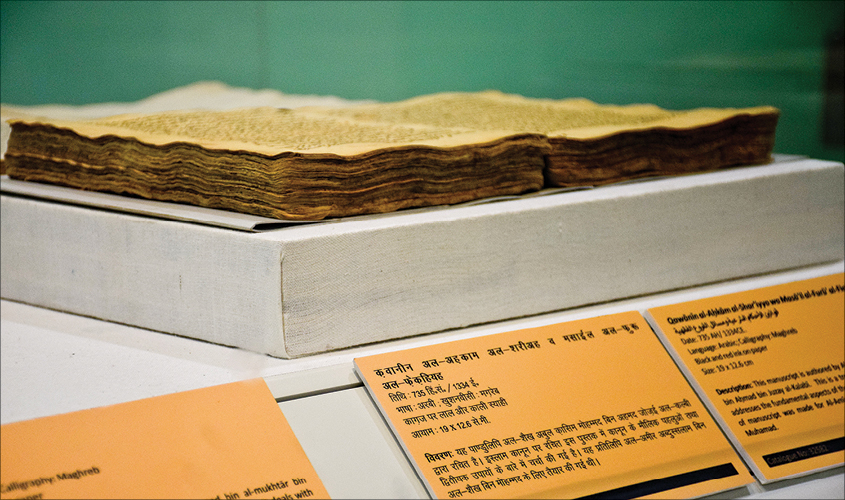A selection of ancient manuscripts from Timbuktu, some of which date back to the 14th century, is the focus of an ongoing exhibition at Delhi’s National Museum. The show is jointly organised by the Governments of India and Mali, writes Bhumika Popli.
This is an exhibition of knowledge. This is the living evidence of what they [the ancient scholars of Timbuktu] were doing. They were spreading knowledge,” said M.J. Akbar, Minister of State for External Affairs, at the launch of Taj Mahal Meets Timbuktu: An Exhibition of Manuscripts of Timbuktu, Mali, now on view at Delhi’s National Museum.
At this show, organised jointly by the Governments of India and Mali, 25 ancient and rare manuscripts from Timbuktu, Mali, have been put on display. These manuscripts, some of which date back to the 14th century, hold a special status in world history as they are known to be an ancient source of knowledge on diverse subjects. The broad list of subject on which these manuscripts are based includes language, grammar, Sufism, good governance, Islamic mysticism, astronomy, jurisprudence and so on.
Some of the ancient texts also contain important correspondences between political and religious leaders of the time, giving us a detailed view of Timbuktu as it existed centuries ago. Today, Timbuktu is known as an ancient city riven by conflict and violence. In 2012, as a response to war-like situation that obtains here, the city was included in UNESCO’s “List of World Heritage
in Danger”.

The people of Mali give considerable importance to their cultural and literary heritage. The literary history of Timbuktu remains incomplete without mentioning Ahmed Baba, the 16th-century scholar whose life was dedicated to disseminating knowledge to anyone who asked for it. He himself wrote as many as 70 books on jurisprudence, grammar and syntax. In 1970, the Ahmed Baba Institute, manuscript library and a research centre and, was opened in Timbuktu as a tribute to the renowned scholar.
Many libraries in Timbuktu are owned by the locals. One example of a privately-owned library is the Mamma Haidara Library, which was started by Abdel Kader Haidara, a former employee of the Ahmed Baba Institute. His library houses his own family’s manuscript collection. His father, Mamma Haidara, was a judge was and a scholar of classical Islamic sciences. According to M.J. Akbar, the manuscripts from the Mamma Haidara Library were “literally smuggled into safety from terrorist attacks”. The same manuscripts are now displayed at the Delhi show.
Timbuktu is going through turbulent times, due to the ongoing war between Islamist rebels and Malian soldiers. Since 2012, militants have destroyed a large part of the city’s cultural heritage, including many shrines and libraries. And it was because of the committed efforts of Haidara and his colleagues that many ancient manuscripts from his library were saved. (The manuscripts were mostly sent to Haidara’s friends and acquaintances.)

Haidara spoke to Guardian 20 about his continuing struggle to protect the ancient manuscripts. “In today’s world, everything poses a serious challenge to the preservation of manuscripts. We have terrorism, dryness, desertification, humidity, thieves and smugglers. All these are enemies of the manuscripts. So, we are at war every day,” he says.
At Delhi’s National Museum, one gets the rare chance of looking at these ancient texts that barely survived the onslaught of history. Among the exhibits is an “illuminated manuscript”—where the text is supplemented with decorated margins and miniature illustrations—which is actually a rare copy of the Quran, from the 16th century. It is written in Arabic and rendered with Maghreb calligraphy, and includes notices of ownership and purchase.
Another manuscript, titled Tuḥfat al-Aḥbāb, is a travelogue written by the great traveller Al-Gharnati. The text describes Al-G harnati’s visits to parts of Egypt, Iraq and Europe among other places of the world. He insightfully writes about the historical facts and description of the topography of the places he has visited.
One of the curators at the National Museum, Khatibur Rahman, who specialises in ancient manuscripts, Arabic and Persian languages, has helped put together this particular exhibition. He said, “The most significant part of this exhibition is that the manuscripts presented here are quite useful for academic purposes as they present the history of thousands of years. One major characteristic of this exhibition also lies in its calligraphic script. Generally in India and central Asia, in Arabic and Persian languages, we find Kufic and Nastaliq script. But here we see African scripts, such as Saharan, Essouk and Maghreb, which is quite unique in itself.”
Taj Mahal Meets Timbuktu: An Exhibition of Manuscripts of Timbuktu, Mali, is on view at Delhi’s National Museum till 6 June

